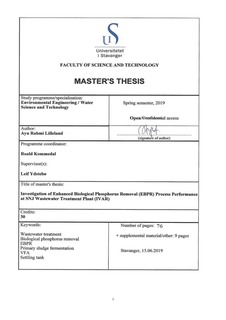| dc.contributor.advisor | Kommedal, Roald | |
| dc.contributor.advisor | Ydstebø, Leif | |
| dc.contributor.author | Lilleland, Ayu Rahmi | |
| dc.contributor.editor | Lilleland, Ayu Rahmi | |
| dc.coverage.spatial | Norway | nb_NO |
| dc.date.accessioned | 2019-10-22T10:22:27Z | |
| dc.date.available | 2019-10-22T10:22:27Z | |
| dc.date.issued | 2019-06-15 | |
| dc.identifier.uri | http://hdl.handle.net/11250/2623674 | |
| dc.description | Master's thesis in Environmental engineering | nb_NO |
| dc.description.abstract | This study has investigated the efficiency of phosphorus (P) removal and optimization the function of the Enhanced Biological Phosphorus Removal (EBPR) at SNJ (Sentralrenseanlegg Nord-Jæren), owned by IVAR (Interkommunalt Vann, Avløp og Renovasjon) at Mekjarvik, Randaberg. During this study, the wastewater was characterized in terms of the relevant substances for EBPR. In addition, tests on primary sludge fermentation and its effect on EBPR were performed. An overview of phosphate release in the bioreactor and in batch tests was performed. Also, measurements of the sludge blanket level in settling tanks were done.
The main results of this project were that the primary sludge had a potential for fermentation of filtered Chemical Oxygen Demand (CODfilt) to VFA (Volatile Fatty Acids) for stimulation of phosphate release and P removal by the EBPR sludge. The conclusion of this test is the primary sludge produced a good substrate for EBPR. The average endogenous and stimulated phosphate release rates in the bioreactor L1 is 1.3 mg P/g VSS h-1 (Volatile Suspended Solids per hour), at temperature 9-10oC and pH 6-7 respectively. This is in category level moderate based on the literature values. The influent average ratio of CODfilt:PO4-P (dissolved P) is 30 g/g which is referred to as near optimal for EBPR. The average treatment efficiency for phosphate in the EBPR plant was a reduction from 1.3 mg/l in the influent to 1.08 mg/l in the effluent. Based on data from SNJ, the average treatment efficiency for P removal is 44.9 %. The main reasons for this low removal were inefficient anaerobic tanks due to oxygen intrusion and PO4-P release (secondary release) in the settling tanks due to anaerobic conditions in the sludge caused by unfavourable hydraulic conditions, and probably too low capacity on the sludge scrapers.
The batch test in the laboratory shows the biological process behave as expected which is phosphate release in the anaerobic reactor and uptake in the aerobic reactor. The conclusion is the sludge has the potential of high phosphate removal if the conditions are optimal. The sludge blanket level in settling tanks was measured and the average SVI (Sludge Volume Index) level was 90.4 mg/l, which indicate good settling and high-quality effluent. But because of high sludge blanket in the settling tank, there was secondary phosphate release and reduced P removal efficiency. Further studies should focus on improving the conditions for EBPR, which mean optimization of the anaerobic tanks and reducing the sludge level in the settling tanks. | nb_NO |
| dc.language.iso | eng | nb_NO |
| dc.publisher | University of Stavanger, Norway | nb_NO |
| dc.relation.ispartofseries | Masteroppgave/UIS-TN-IKBM/2019; | |
| dc.subject | EBPR | nb_NO |
| dc.subject | VFA | nb_NO |
| dc.subject | teknisk miljøvern | nb_NO |
| dc.subject | miljøteknologi | nb_NO |
| dc.subject | vann | nb_NO |
| dc.subject | wastewater treatment | nb_NO |
| dc.subject | biological phosphorus removal | nb_NO |
| dc.subject | primary sludge | nb_NO |
| dc.subject | settling tank | nb_NO |
| dc.title | Investigation of Enhanced Biological Phosphorus Removal (EBPR) Process Performance at SNJ Wastewater Treatment Plant (IVAR) | nb_NO |
| dc.type | Master thesis | nb_NO |
| dc.subject.nsi | VDP::Technology: 500::Environmental engineering: 610 | nb_NO |
